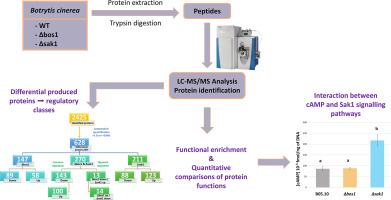当前位置:
X-MOL 学术
›
J. Proteomics
›
论文详情
Our official English website, www.x-mol.net, welcomes your
feedback! (Note: you will need to create a separate account there.)
Comparative quantitative proteomics of osmotic signal transduction mutants in Botrytis cinerea explain mutant phenotypes and highlight interaction with cAMP and Ca2+ signalling pathways.
Journal of Proteomics ( IF 2.8 ) Pub Date : 2019-11-13 , DOI: 10.1016/j.jprot.2019.103580 Jaafar Kilani 1 , Marlène Davanture 2 , Adeline Simon 3 , Michel Zivy 2 , Sabine Fillinger 3
Journal of Proteomics ( IF 2.8 ) Pub Date : 2019-11-13 , DOI: 10.1016/j.jprot.2019.103580 Jaafar Kilani 1 , Marlène Davanture 2 , Adeline Simon 3 , Michel Zivy 2 , Sabine Fillinger 3
Affiliation

|
Signal transduction (ST) is essential for rapid adaptive responses to changing environmental conditions. It acts through rapid post-translational modifications of signalling proteins and downstream effectors that regulate the activity and/or subcellular localisation of target proteins, or the expression of downstream genes. We have performed a quantitative, comparative proteomics study of ST mutants in the phytopathogenic fungus Botrytis cinerea during axenic growth under non-stressed conditions to decipher the roles of two kinases of the hyper-osmolarity pathway in B. cinerea physiology. We studied the mutants of the sensor histidine kinase Bos1 and of the MAP kinase Sak1. Label-free shotgun proteomics detected 2425 proteins, 628 differentially abundant between mutants and wild-type, 270 common to both mutants, indicating independent and shared regulatory functions for both kinases. Gene ontology analysis showed significant changes in functional categories that may explain in vitro growth and virulence defects of both mutants (secondary metabolism enzymes, lytic enzymes, proteins linked to osmotic, oxidative and cell wall stress). The proteome data also highlight a new link between Sak1 MAPK, cAMP and Ca2+ signalling. This study reveals the potential of proteomic analyses of signal transduction mutants to decipher their biological functions. TEXT-VULGARISATION: The fungus Botrytis cinerea is responsible for grey mold disease of hundreds of plant species. During infection, the fungus has to face important changes of its environment. Adaptation to these changing environmental conditions involves proteins of such called signal transduction pathways that regulate the production, activity or localisation of cellular components, mainly proteins. While the components of such signal transduction pathways are well known, their role globally understood, the precise impact on protein production remains unknown. In this study we have analysed and compared the global protein content of two Botrytis cinerea signal transduction mutants - both avirulent - to the pathogenic parental strain. The data of 628 differential proteins between mutants and wild-type, showed significant changes in proteins related to plant infection (secondary metabolism enzymes, lytic enzymes, proteins linked to osmotic, oxidative and cell wall stress) that may explain the virulence defects of both mutants. Moreover, we observed intracellular accumulation of secreted proteins in one of the mutants suggesting a potential secretion defect.
中文翻译:

灰葡萄孢中渗透信号转导突变体的比较定量蛋白质组学解释了突变体表型,并突出了与cAMP和Ca2 +信号通路的相互作用。
信号转导(ST)对于对不断变化的环境条件进行快速自适应响应至关重要。它通过信号蛋白和下游效应子的快速翻译后修饰来调节靶蛋白的活性和/或亚细胞定位或下游基因的表达。我们已进行了植物病原性真菌灰葡萄孢中ST突变体在非胁迫条件下的轴突生长过程中的定量,比较蛋白质组学研究,以破译高渗透性途径的两种激酶在灰质芽孢杆菌生理中的作用。我们研究了传感器组氨酸激酶Bos1和MAP激酶Sak1的突变体。无标记shot弹枪蛋白质组学检测到2425种蛋白质,突变体和野生型之间差异丰富的628种,两种突变体共有的270种,表明这两种激酶具有独立和共享的调节功能。基因本体分析显示功能类别上的重大变化,可以解释两个突变体的体外生长和毒力缺陷(二次代谢酶,裂解酶,与渗透,氧化和细胞壁应激有关的蛋白质)。蛋白质组数据还突显了Sak1 MAPK,cAMP和Ca2 +信号传导之间的新联系。这项研究揭示了信号转导突变体的蛋白质组学分析破译其生物学功能的潜力。文本变异:真菌灰葡萄孢(Botrytis cinerea)是造成数百种植物灰霉病的原因。在感染期间,真菌必须面对其环境的重要变化。对这些不断变化的环境条件的适应涉及所谓的信号转导途径的蛋白质,其调节细胞成分(主要是蛋白质)的产生,活性或定位。尽管这种信号转导途径的成分是众所周知的,但它们的作用已为全球所了解,但对蛋白质生产的确切影响仍然未知。在这项研究中,我们分析并比较了两种灰葡萄孢信号转导突变体(均无毒)和致病性亲本菌株的总体蛋白质含量。突变体和野生型之间的628种差异蛋白的数据表明,与植物感染相关的蛋白(次级代谢酶,裂解酶,与渗透压,氧化和细胞壁胁迫相关的蛋白)发生了显着变化,这可能解释了两个突变体的毒力缺陷。 。而且,
更新日期:2019-11-13
中文翻译:

灰葡萄孢中渗透信号转导突变体的比较定量蛋白质组学解释了突变体表型,并突出了与cAMP和Ca2 +信号通路的相互作用。
信号转导(ST)对于对不断变化的环境条件进行快速自适应响应至关重要。它通过信号蛋白和下游效应子的快速翻译后修饰来调节靶蛋白的活性和/或亚细胞定位或下游基因的表达。我们已进行了植物病原性真菌灰葡萄孢中ST突变体在非胁迫条件下的轴突生长过程中的定量,比较蛋白质组学研究,以破译高渗透性途径的两种激酶在灰质芽孢杆菌生理中的作用。我们研究了传感器组氨酸激酶Bos1和MAP激酶Sak1的突变体。无标记shot弹枪蛋白质组学检测到2425种蛋白质,突变体和野生型之间差异丰富的628种,两种突变体共有的270种,表明这两种激酶具有独立和共享的调节功能。基因本体分析显示功能类别上的重大变化,可以解释两个突变体的体外生长和毒力缺陷(二次代谢酶,裂解酶,与渗透,氧化和细胞壁应激有关的蛋白质)。蛋白质组数据还突显了Sak1 MAPK,cAMP和Ca2 +信号传导之间的新联系。这项研究揭示了信号转导突变体的蛋白质组学分析破译其生物学功能的潜力。文本变异:真菌灰葡萄孢(Botrytis cinerea)是造成数百种植物灰霉病的原因。在感染期间,真菌必须面对其环境的重要变化。对这些不断变化的环境条件的适应涉及所谓的信号转导途径的蛋白质,其调节细胞成分(主要是蛋白质)的产生,活性或定位。尽管这种信号转导途径的成分是众所周知的,但它们的作用已为全球所了解,但对蛋白质生产的确切影响仍然未知。在这项研究中,我们分析并比较了两种灰葡萄孢信号转导突变体(均无毒)和致病性亲本菌株的总体蛋白质含量。突变体和野生型之间的628种差异蛋白的数据表明,与植物感染相关的蛋白(次级代谢酶,裂解酶,与渗透压,氧化和细胞壁胁迫相关的蛋白)发生了显着变化,这可能解释了两个突变体的毒力缺陷。 。而且,











































 京公网安备 11010802027423号
京公网安备 11010802027423号